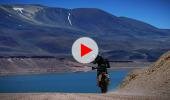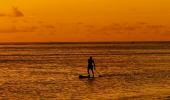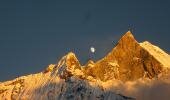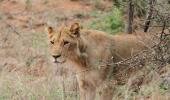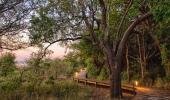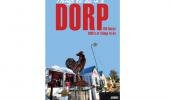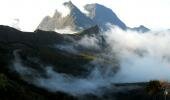Words & Photos by Xen & Adri Ludick
In 1995, the Mabuasehube Game Reserve was amalgamated into the Gemsbok National Park to form the Kgalagadi Transfrontier Park. Mabua, as we like to call it, is a gem for camping and seeing wildlife in the southern Kalahari, and is where we’ve experienced the most incredible encounters with animals and nature. It tops our list of favorite places to visit!
In the early years you didn’t need to book, as only a few people knew about this hidden treasure. More recently though, there has been a spate of articles about this Kalahari destination that has resulted in it becoming a major tourist attraction. Securing a campsite, especially during the school holidays, is almost impossible unless you book early. Our advice is to book a year in advance.
The first time I visited Mabua was also the first time I stayed in a roof tent, showered under a tree and used a pit toilet. I can still clearly remember the first night Xen and I spent in the park, made all the more memorable after counting seven satellites pass over us in a clear African sky. Definitely not something you‘ll see in a concrete jungle!
Of the many highlights we’ve experienced at Mabua, we have enjoyed numerous cat encounters. We’ve had the rare privilege of watching a pack of lions; one male, two females and four gorgeous cubs grow into mature, majestic Kalahari lions during our follow up visits. We’ve also witnessed two lions mating on our designated campsite in Khiding. For two days the lions continued to mate, not more than 30 metres away from us, and when they finally moved on, their parting felt like family leaving home on a long trip, not knowing when you would meet again.
Leopard sightings are also high up on our list of memorable experiences, and one such occasion was at the Monamodi Pans. We had been sitting quietly around the fire and as Xen got up to move a stump on the fire (as men do), his headlight lamp picked up eyes in the track leading to the camp. It turned out to be a beautiful leopard licking its paws and lazily washing itself not more than 25 metres away from us. Within the safety of our roof tent, we marvelled at this beautiful creature circling below us for about 20 minutes. On another trip, while driving from Khakea to Khokhotsa pan on the cut line, we also encountered a leopard in the middle of the day, which is quite an experience in itself, as they are generally nocturnal.
We’ve also seen cheetahs whilst camping at Mpaathutlwa Pan. Two huge cheetahs silently entered our camp, then casually sauntered up to a tree and had a good rub before disappearing into the secrecy of the foliage.
A disturbing pattern that’s starting to unfold though is that some of the animals, mainly jackals and hyena, are coming into the campsites for food, and is an indication that travellers are feeding them. Not only is this illegal, it’s very foolish. There was an article just recently about a leopard that caught a jackal in a Mabua campsite. For years we have enjoyed this jackal’s visits, but never feed him. Sadly, not all travellers share our views and now this jackal is no more because of the reckless feeding of animals.
No matter how cute, cuddly or docile these animals appear, one can never forget that they are wild animals. We were reminded of this one morning as we were leaving for Gauteng. Approaching the exit gate, a pride of lions had blocked our way. It was the same pride we had watched since they were cubs. Unable to get out and lift the boom, we decided to drive around and through the veld. The lions were unperturbed until we drove over a small drinking hole and then all mayhem broke loose. Without warning, the male started to chase us and the look in its eyes turned deadly. When we stopped it stopped and when we moved it came for us. It continued to chase us for about another 50 metres before giving up. That was pretty scary!
We’ve found that most people visiting the park only want to see the larger animals. So it breaks our hearts when we hear them say they saw nothing noteworthy because they were only on the lookout for the Big Five. Yet had they looked, they would have found a thriving community of ground squirrels, franklins, hornbills, scorpions, centipedes and much more; each special in their own unique way. How can one not thrill at the sight of a Khori Bustard as it puffs out its breast feathers in a magnificent display to attract several females and mate with them all, or ignore the mating call of a male ostrich. How many people run for shelter when the first lightning bolt strikes and forget to just sit and enjoy a majestic fireworks display that lights up the African sky for hundreds of miles? They also would have missed out on a family of bat-eared foxes walking slowly and quietly by with their noses to the ground and ears cocked forward as they listen for insects, or forgot to enjoy the playfulness of a newly born springbuck.
This said, the park is not only about the animals and birds; it is home to an amazing array of flora. Travelling from Mabua to Nossob on the access track during the rain season, we’ve seen the most beautiful flowers including Dune Lilies, Nerinas and Devil’s Thorn flowers, which painted the veld in a yellow canvas.
One of the main reasons we go to Mabua is to get away from it all; television, news, people, cellphones, bright lights and noise. Yet many of its visitors bring their high-powered lights that create a stadium effect in the wilderness, talk loudly and laugh raucously. No wonder the animals of the night don’t visit them!
Travelling in the bush also comes with its own challenges and being prepared for any eventuality, including vehicle breakdowns or problems, is essential. One such trip occurred when our twin sons and their two friends joined us for a long weekend at Mabua. With great excitement we left Gauteng; four young men in a Mazda Drifter and Xen and I in our trusty 80 Series Cruiser. We chose the McCarthy’s Rest route as it would be a special experience for the boys, offering lots of deep sand that required total concentration at all times. We’d been travelling for approximately 60km on a two spoor track when the Drifter came to a sudden halt.
Finding nothing we continued on only to stop again five kilometres down the road, with a flat tyre. Xen quickly sorted it out using the puncture repair kit and we were on our way once again. But alas, just two kilometres into the park and the Drifter broke down again. This time we discovered that the trailing arm holder had cracked – this was serious! The closest welder was more than 200km away and it was already getting dark, so the only hope of fixing the bracket was to be found at our campsite, 23km away. Travelling at 10km/h, we finally reached the campsite and decided the repair could wait until morning, as the thought of a chilled drink sounded like a much better option.
The next morning, the wheel and damaged part were removed and a loose piece of metal, removed from the vehicle and placed in the fire, would serve as a bracket. Holes were then punched into the makeshift bracket for the bolts. Pratley steel, binding wire and the new bracket were employed and left to set for the rest of the day, as we went on a game drive and spotted a hyena and two cheetahs – just reward! So did the Drifter make it back to Gauteng? Of course it did. And when they went to replace the bush repair with a new unit back home, they were told that their makeshift bracket was much stronger than a new one would be. Special moments!
We could write volumes about our experiences at Mabua, but there are just too many. So we highly recommend that you experience it for yourself, and here’s how.
Getting to Mabuasehube
There are four route options:
Option 1:
The easiest option. Travelling from Gauteng, enter Botswana at Lobatsi and travel to Sakoma on the Trans Kalahari Highway. You will need to fill up with petrol in Jwaneng. At Sakoma turn left (south) towards Kokotsha. Diesel is available at Sakoma. Approximately 45km past Khokhotsa, take the Mabuasehube turn off to the right (west). Go through the gate and remember to close it as you are entering private cattle ranches. This is also a good time to deflate your tyres to two bars. Mabuasehube is 135km further on a two track spoor.
Option 2:
Challenging due to thick sand. Travel as described above and continue past Sakoma to Kang, where you will turn left (south) towards Hukuntsi and then Mabuasehube. Petrol and diesel are available at both Kang and Hukuntsi.
Option 3:
Easy option. This alternative route from Gauteng is via Vryburg to Tosca and across the border at Werda towards Khokhotsa. Approximately 45km after Khokhotsa, you will find the Mabuasehube turn off on your left. Continue as described above.
Option 4:
Challenging due to thick sand. You could enter from the south via the McCarthy’s Rest Border Post. From Gauteng travel to Vryburg and on to Vostershoop. This is where you could fill up with fuel, or overnight at the Malopo Nature Reserve (tell Gerald and Ina I sent you), before heading towards McCarthy’s Rest. From there continue to Tshabong where there is petrol and diesel, but be warned there are intermittent supply problems. From Tshabong follow the road signs to Mabuasehube.
Safe travels and enjoy the journey!
Travel tips
1) Have enough water, fuel and food with you, as this is an isolated part of Botswana.
2) Watch out for ground squirrel and porcupine boroughs because you could destroy your vehicle’s suspension if you hit one.
3) A good map and GPS are essential.
4) A one- or two-million candle power spotlight is great at night on the pans.
5) Leave the generator at home, it’s not allowed in the park. Rather try a good solar system.
6) You may not collect firewood in the park and there is a hefty fine if caught.
7) Have a decent tool kit with you that includes binding wire, threaded rods with washers and nuts of various sizes, hacksaw, tie-ends of various sizes, radiator cement or eggs, hammer, punch for making holes, mirror to attract the attention of other travellers and a cordless drill with drill bits.
8) And most important - don’t forget a well-equipped medical kit.
To book
Email:
Our vehicle and accessories fitted
We kitted our 1996 Toyota 80 Series Land Cruiser out with the following: OME suspension with steering damper, air dampers in the rear coils, dual battery with solar panel, long range fuel tank, two way radios + 29 MHz radio, roof rack with roof tent and awning for the rain, 2 x Engel 40-litre fridges, African Outback drawer system, 800 Watt inverter to charge cameras and satellite phone and changed the BF Goodrich All Terrain tyres to Mud Terrain (285/75/16).
